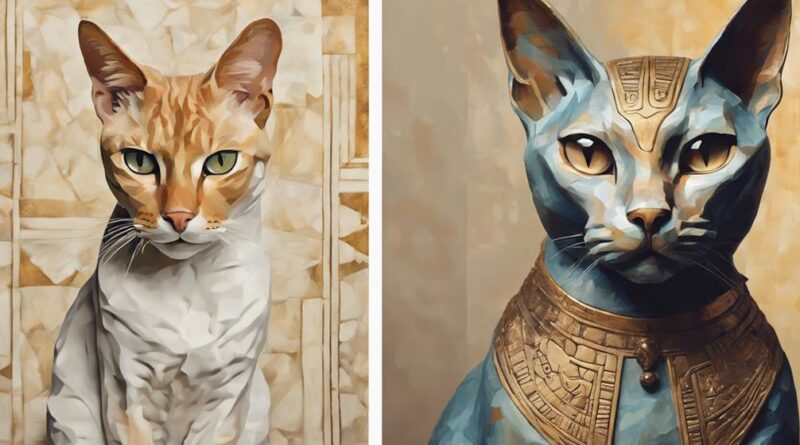15 Key Moments of Felines in Artistic History
Discover the impact of felines in art history, from ancient Egyptian worship to modern interpretations. Witness the intricate cat sculptures adored by ancient Egyptians and the symbolic depth of cats in Greek mythology. Explore how medieval manuscripts and Renaissance portraits portrayed cats beyond mere representation. Appreciate cats in Japanese woodblock prints for their luck symbolism and the luxurious Art Deco cat figurines. Dive into the surrealistic world with distorted cat depictions. Uncover how modern art movements like Pop Art and Urban Art feature cats, influencing fashion and urban landscapes. The mesmerizing journey of felines in art awaits your exploration.
Ancient Egyptian Cat Sculptures
Ancient Egyptian cat sculptures, revered for their intricate craftsmanship and symbolic significance, played a vital role in the artistic expression of this ancient civilization. Egyptian cat worship was a central aspect of their culture, with cats being seen as sacred animals associated with the goddess Bastet, who represented protection, fertility, and motherhood. The representation of cats in sculptures wasn't merely artistic but held deep religious and cultural meanings.
These sculptures weren't just artistic representations but also served practical purposes. Feline mummies were commonly created as offerings to the gods, symbolizing the eternal connection between the physical and spiritual worlds. The intricate details in these sculptures, from the gentle curves of the feline form to the elaborate hieroglyphics adorning them, reflected the Egyptians' reverence for these creatures.
The significance of Egyptian cat sculptures extended beyond religious beliefs; they also reflected the Egyptians' advanced artistic skills. The attention to detail in these sculptures, often made from materials like bronze and precious stones, showcased the craftsmanship of ancient Egyptian artisans. Through these sculptures, the Egyptians immortalized their beliefs, customs, and artistic capabilities, leaving a lasting legacy that continues to fascinate and inspire artists and historians alike.
Cat Symbolism in Greek Mythology
In Greek mythology, cats held significant symbolic roles that intertwined with the divine narratives of the gods and goddesses, offering a unique perspective on feline representation in ancient lore. Here's a closer look at the cat symbolism in Greek mythology:
- Guardianship and Protection: Cats were often associated with the goddess Artemis, the protector of nature and the hunt. Just like cats are known for their agility and hunting skills, Artemis's connection with these animals symbolized her role as a guardian and protector in Greek mythology.
- Mystery and Magic: Cats were also linked to magic and mystery in Greek mythology, particularly through the figure of Hecate, the goddess of magic, witchcraft, and crossroads. Hecate's association with cats emphasized their enigmatic nature and their ability to move between the seen and unseen worlds.
- Underworld Guides: In the myth of Persephone's abduction by Hades, it's said that Hecate sent a pack of furious, howling dogs to aid in the search for Persephone. However, some interpretations suggest that Hecate's animal companions could also include cats, signifying their role as guides between the world of the living and the realm of the dead. This ties cats to the mystical and liminal aspects of Greek mythology, enhancing their cultural significance as creatures of transition and transformation.
Cats in Medieval Manuscripts
Exploring medieval manuscripts reveals a rich tapestry of feline depictions intertwined with religious, cultural, and artistic contexts. In the Middle Ages, cats were frequently featured in various forms of artistic expression, including medieval cat tapestries and illuminated manuscripts. These depictions often carried symbolic meanings beyond the mere representation of the animals themselves.
In illuminated manuscripts, cats were sometimes depicted as playful companions to humans, illustrating scenes of domestic life or hunting activities. These intricate illustrations not only showcased the artistic skills of the medieval scribes and illustrators but also highlighted the significance of cats in medieval society.
Furthermore, feline motifs were prevalent in the architectural designs of Gothic cathedrals and churches. Stone carvings, stained glass windows, and decorative elements often incorporated cat-like figures, symbolizing various attributes such as agility, grace, and guardianship. These motifs served not only as ornamental features but also as symbolic representations within the religious and cultural contexts of the medieval period.
Renaissance Portraits of Cats
Delving into the Renaissance period unveils a captivating array of artistic portrayals featuring cats as subjects in elaborate and nuanced portraits. During this time, cats weren't merely depicted as pets but were often symbolic representations of various virtues or vices. Let's explore how cats were portrayed in Renaissance art:
- Cat Fashion, Renaissance: Cats in Renaissance portraits were often adorned with luxurious accessories like collars with bells or ribbons, symbolizing the wealth and status of their owners. These fashionable felines added a touch of opulence to the paintings, showcasing the extravagance of the era.
- Cat Memes, Renaissance Portraits: In a time before the internet, cats in Renaissance portraits served as subtle satire or humorous elements. Artists sometimes included cats in unexpected or comical situations, providing a touch of levity to the serious and often grandiose portraits of the period. These playful depictions added a layer of depth and whimsy to the artworks.
- Symbolism and Mystique: Cats in Renaissance portraits weren't just decorative elements but held deeper symbolic meanings. They were often associated with traits like independence, mystery, and cunning. Artists used cats to convey complex allegorical messages or to represent the dual nature of human existence, blending the mundane with the enigmatic in their compositions.
These Renaissance portraits of cats not only showcased the artistic skill of the painters but also revealed the societal attitudes towards these enigmatic creatures during that period.
Cats in Japanese Woodblock Prints
Renaissance artists' fascination with cats transcended borders and eras, leading to a notable presence of these intriguing felines in Japanese Woodblock Prints. Cats in Japanese Woodblock Prints hold a significant cultural and artistic value, reflecting the deep-rooted admiration for these animals in Japanese society.
Japanese Woodblock Prints, or Ukiyo-e, emerged during the Edo period (1603-1868) and often featured cats in various settings. These prints depicted cats as symbols of luck, protection, and sometimes mischief. Cats were portrayed in scenes that ranged from tranquil moments of grooming to dynamic hunting poses, capturing the essence of these creatures in a stylized yet authentic manner.
In Japanese culture, cats hold a special place, evident in the popularity of cat cafes where people can interact with feline companions. This deep connection with cats is also reflected in contemporary manga, where cats are often anthropomorphized and play diverse roles in storytelling. Manga cats, with their expressive eyes and playful antics, continue the tradition of celebrating these enigmatic creatures in Japanese art.
Impressionist Paintings Featuring Cats
Impressionist painters masterfully incorporated cats into their works, adding a touch of charm and intrigue to their captivating compositions. These feline muses became integral to the storytelling within the art of this era. Let's delve into why cats were a popular subject among Impressionist artists:
- Graceful Elegance: Cats were often depicted in Impressionist paintings for their graceful movements and elegant postures. The artists skillfully captured the sleek lines and fluidity of these animals, enhancing the overall aesthetic of their works.
- Whimsical Interactions: Cats in Impressionist paintings weren't merely decorative elements but often served as active participants in the scenes, engaging with other subjects or objects. This added a playful and sometimes mysterious element to the artworks, drawing viewers into the narrative.
- Symbolism and Allegory: Beyond their physical presence, cats in Impressionist paintings were sometimes imbued with symbolic meanings or used allegorically to convey deeper messages. They could represent independence, mystery, or even the fleeting nature of beauty, adding layers of complexity to the artworks.
In today's world, where cats continue to be celebrated through cat cafes as a cultural phenomenon and have even become internet sensations through cat memes, it's fascinating to see how their timeless appeal has transcended centuries and art movements.
Art Deco Cat Figurines
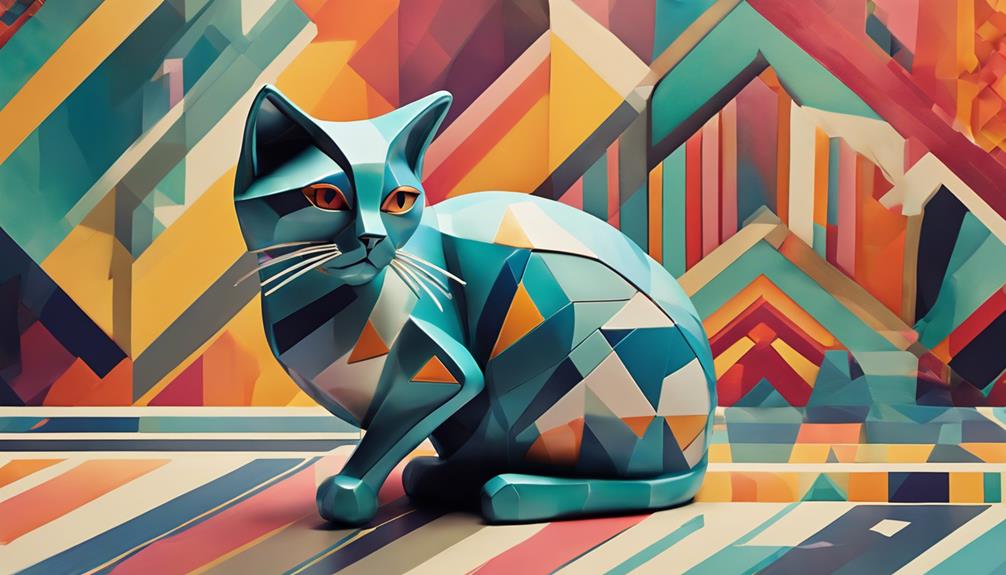
Exploring the intricate craftsmanship and sleek designs of Art Deco cat figurines reveals a unique blend of elegance and modernity in the world of decorative arts. These figurines, popular during the 1920s and 1930s, represent a shift towards more stylized and geometric forms. Art Deco cat figurines are modern interpretations of feline forms, characterized by sharp lines, bold colors, and a sense of luxury. The sleek and streamlined aesthetic of Art Deco design is evident in these figurines, capturing the essence of the era's fascination with progress and innovation.
Art Deco cat figurines aren't only decorative pieces but also highly sought-after collectible items. Due to their popularity and historical significance, these figurines are often cherished by collectors and enthusiasts of Art Deco art. The craftsmanship and attention to detail in these figurines make them valuable pieces that showcase the creativity and artistry of the period.
The modern interpretations of cats in Art Deco cat figurines offer a glimpse into the evolving artistic trends of the early 20th century. By combining traditional subject matter with contemporary design elements, these figurines exemplify the fusion of past and present in the world of decorative arts. Whether displayed as standalone pieces or as part of a collection, Art Deco cat figurines continue to captivate art lovers with their timeless appeal and distinctive style.
Surrealist Depictions of Cats
Surrealist depictions of cats in art often transcend the boundaries of reality, offering viewers a whimsical and dreamlike interpretation of feline presence. When exploring the realm of surrealist cat paintings, you delve into a world where imagination reigns supreme, and the familiar form of a cat is twisted into fantastical shapes and contexts.
- Symbolism: Surrealist cat paintings often use feline figures to symbolize various emotions, desires, or fears. Cats, known for their mysterious nature, agility, and independence, serve as a rich symbol for artists to convey deeper meanings within their works. From representing the subconscious mind to embodying freedom from societal constraints, the symbolism behind cats in surrealism adds layers of complexity to the artistic narrative.
- Distorted Realities: Cat-inspired surrealism frequently distorts the traditional depiction of cats, manipulating their form, size, and context to create a sense of unease or wonder. Through this distortion, artists challenge the viewer's perception of reality, inviting them to question what's possible and what's illusion in the realm of art.
- Dreamlike Atmosphere: Surrealist cat paintings often evoke a dreamlike atmosphere, where the rules of the physical world are suspended, and the boundaries between imagination and reality blur. Cats, with their enigmatic presence, add an element of mystery and intrigue to these surrealistic settings, inviting viewers to immerse themselves in a world where the impossible becomes possible.
Cats in Pop Art
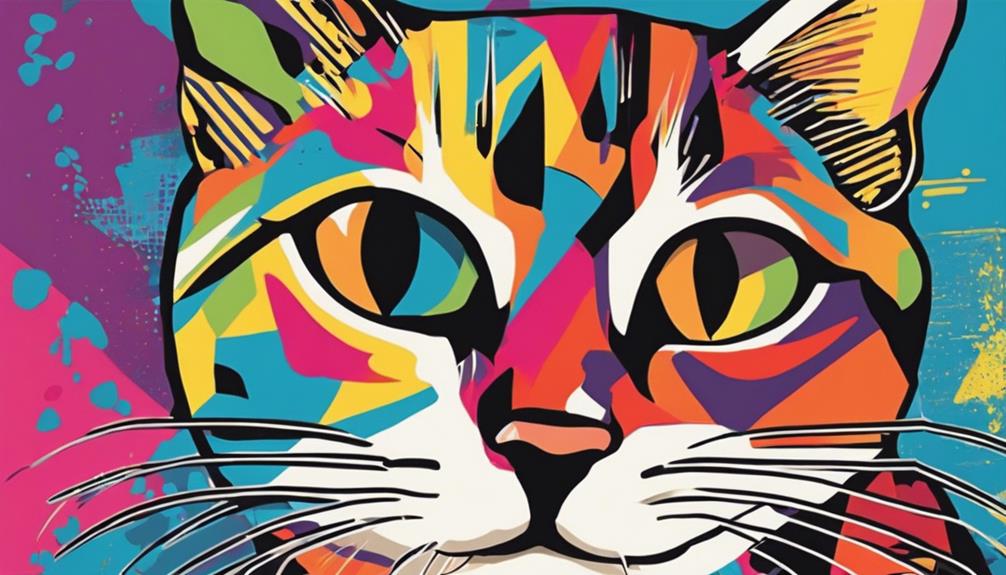
In the vibrant realm of Pop Art, cats become iconic symbols of popular culture, injecting a playful and colorful energy into the artistic landscape. Pop Art emerged in the 1950s and 1960s, celebrating everyday objects and popular imagery. Cats quickly found their way into this movement, often depicted in bold and vibrant colors, reflecting the dynamic essence of the era.
Cat memes, a prevalent form of internet humor, have become intertwined with Pop Art in the digital age. Artists have incorporated these humorous and relatable images into their work, blurring the lines between online culture and traditional art. Social media platforms have played a significant role in the dissemination of these cat-themed artworks, further solidifying felines as enduring symbols in the world of Pop Art.
Moreover, cats haven't only influenced the digital realm but also made their mark in cat fashion and accessories. From clothing adorned with cat prints to accessories shaped like whiskers and ears, feline motifs have become a staple in the fashion industry. Designers draw inspiration from the playful and enigmatic nature of cats, creating pieces that resonate with cat lovers worldwide.
Contemporary Cat Photography
Contemporary cat photography captures the essence of feline grace and charm through innovative perspectives and artistic techniques. In the modern era, photographers have taken cat portraits to new heights, showcasing these beloved pets in creative and captivating ways.
Here are three key aspects that make contemporary cat photography stand out:
- Feline Fashion: Contemporary cat photography often incorporates elements of feline fashion, where cats are dressed in stylish outfits or accessories. From elegant bow ties to trendy scarves, these fashion-forward felines add a playful and fashionable touch to photoshoots, showcasing the intersection of pets and style.
- Quirky Cat Poses: One of the hallmarks of contemporary cat photography is the use of quirky cat poses that bring out the individual personalities of the feline subjects. Whether captured mid-stretch, in a playful pounce, or lounging in a whimsical position, these poses add a sense of fun and spontaneity to the photographs, making them truly unique and engaging.
- Artistic Techniques: Contemporary cat photographers employ a variety of artistic techniques to elevate their work. From creative lighting and composition to the use of props and backgrounds, these photographers push the boundaries of traditional pet photography, creating stunning visual narratives that celebrate the beauty and charm of cats in a modern context.
Cat Sculptures by Picasso

Picasso's cat sculptures showcase a unique blend of cubist influences and feline forms, exemplifying his innovative approach to capturing the essence of these beloved animals in three-dimensional art. His modern interpretations of cats through abstract sculptures reveal a deep exploration of shape and form. Picasso's cultural influences, particularly his Spanish heritage, are evident in the minimalist designs of his cat sculptures.
In Picasso's hands, cats transform into geometric marvels, where sleek lines and sharp angles convey a sense of constant movement and fluidity. The artist's ability to distill the essence of a cat into its most fundamental shapes and lines is remarkable. Each sculpture seems to capture the very spirit of feline grace and mystery.
The abstract nature of Picasso's cat sculptures allows viewers to engage with the artwork on a purely visual and emotional level. The absence of intricate details compels the observer to focus on the overall form and structure, inviting a deeper contemplation of the feline form. Picasso's cat sculptures stand as a testament to his artistic vision and his ability to transcend traditional representation, offering a fresh perspective on the intersection of art and nature.
Cats in Street Art
Embracing the vibrant streets with their enigmatic presence, feline figures in street art captivate passersby with their whimsical and often thought-provoking designs. Cats in graffiti and cat murals in urban settings add a touch of mystery and charm to city landscapes. Here are three aspects that make cats in street art truly captivating:
- Symbolism: Cats have been a recurring motif in street art due to their symbolic meanings. Often representing independence, mystery, and agility, these feline creatures bring a sense of enigma to the urban environment. Artists use cats in graffiti to convey messages of freedom or rebellion subtly.
- Integration with Surroundings: Cat murals in urban settings aren't just standalone pieces but are integrated into the surroundings in creative ways. You might stumble upon a cat seemingly interacting with a real-life object like a lamppost or blending into the architecture of the building, creating an illusion that delights viewers.
- Community Engagement: Street art featuring cats often sparks conversations among locals and tourists alike. People stop to admire, take photos, and discuss the significance of these artworks, fostering a sense of community appreciation for art in public spaces. The presence of cat-themed murals adds a playful and welcoming atmosphere to the bustling streets, inviting everyone to pause and appreciate the beauty of these feline-inspired creations.
Cats in Video Art Installations
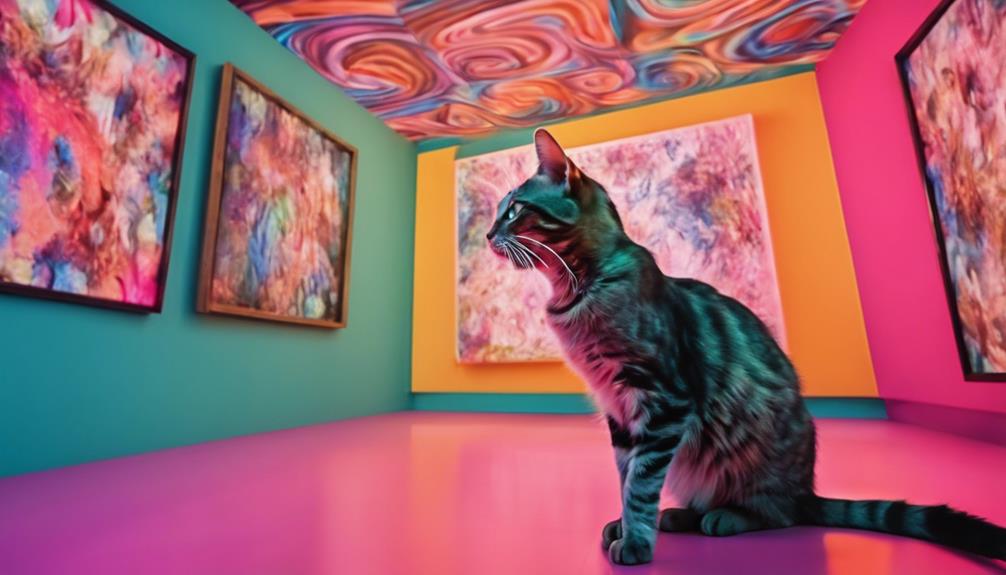
In video art installations, cats take on a dynamic role, engaging viewers with their captivating movements and interactions within the digital realm. These interactive installations often showcase various aspects of cat behavior, from playful antics to moments of serene contemplation, creating a unique and immersive experience for the audience.
Through innovative use of technology, artists have been able to capture the essence of feline behavior in ways that are both entertaining and thought-provoking. Cats in video art installations aren't merely passive subjects but active participants, responding to stimuli and engaging with their surroundings in unexpected ways. This dynamic interaction between the viewer and the digital feline creates a sense of presence and immediacy that transcends traditional artistic boundaries.
Cat behavior, with its inherent unpredictability and grace, lends itself well to the interactive nature of these installations. Whether chasing a virtual ball of yarn or simply lounging in a sunlit digital environment, the cats in video art installations evoke a range of emotions and responses from those who encounter them. By incorporating elements of playfulness, curiosity, and independence, artists are able to tap into the timeless appeal of felines and create engaging narratives that resonate with audiences of all ages.
Cat Illustrations in Children's Books
Cat illustrations in children's books have long been cherished for their ability to enchant young readers with whimsical depictions of feline characters. When exploring this captivating world of art, you'll find that cat character design and animal symbolism play crucial roles in shaping these beloved illustrations.
Here's a closer look at what makes cat illustrations in children's books so special:
- Cat Character Design: In children's books, cats are often anthropomorphized to appeal to the young audience. Their designs range from realistic to fantastical, with characteristics that emphasize cuteness and playfulness. Through unique traits like big expressive eyes or colorful fur patterns, illustrators create memorable cat characters that resonate with children.
- Animal Symbolism: Cats have been symbols of various qualities throughout history, such as mystery, independence, or cleverness. In children's books, these symbols are subtly woven into the illustrations to add depth to the stories. Whether a cat is portrayed as a wise mentor or a mischievous companion, the symbolic representation enriches the narrative and encourages young readers to think beyond the surface.
- Illustrating Cat Behavior, Artistic Interpretations: Cat behavior, like curiosity, agility, or affection, is often depicted in children's book illustrations. Artists skillfully capture these behaviors through dynamic poses, expressive faces, and intricate detailing. These illustrations not only showcase the beauty of feline movements but also serve as artistic interpretations that ignite the imagination of children.
Cats in Digital Art
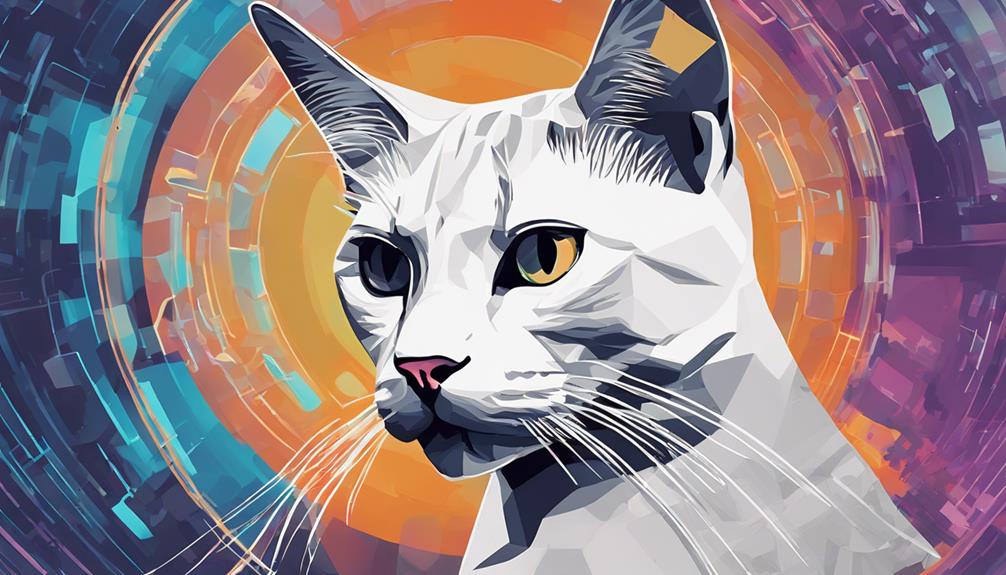
Digital art has revolutionized the portrayal of felines, offering artists innovative tools to redefine traditional representations. In the realm of digital art, cats have found a vibrant and dynamic space to inhabit. Artists now have the ability to create interactive cat animations that engage audiences in unprecedented ways. These interactive cat animations breathe life into feline characters, allowing viewers to interact with them on a whole new level.
Digital cat portraits have also become increasingly popular, showcasing the versatility and adaptability of feline subjects in the digital medium. Artists can now experiment with different styles, colors, and textures to create visually striking portraits that capture the essence of their feline muses. From hyper-realistic depictions to abstract interpretations, digital cat portraits offer a wide range of artistic possibilities for creators to explore.
Through digital art, cats have transcended traditional boundaries and leaped into the realm of innovation and creativity. The digital medium allows artists to push the limits of imagination, bringing feline characters to life in ways never before possible. Interactive cat animations and digital cat portraits stand as testaments to the boundless potential of felines in the digital art world, captivating audiences and inspiring artists to continue reimagining the timeless charm of these beloved creatures.
Frequently Asked Questions
How Did Cats Influence the Development of Ancient Egyptian Culture?
Cats deeply influenced ancient Egyptian culture by playing pivotal roles in both relationship dynamics and religious significance. In Egyptian society, cats were revered for their grace and hunting abilities, earning them a special place in households.
These feline companions were also associated with various deities, especially Bastet, the goddess of home, fertility, and protection. Their sacred status symbolized the importance of balance and harmony in Ancient Egypt's spiritual beliefs.
What Symbolic Meanings Do Cats Hold in Greek Mythology?
In Greek mythology, cats symbolize various meanings. They're seen as guardians, protecting homes from evil spirits. Cats are also viewed as companions, providing comfort and companionship to individuals.
Their grace, agility, and mysterious nature have inspired stories and legends in Greek culture. Cats hold a special place in Greek mythology, embodying qualities of protection, loyalty, and independence. Their presence in myths reflects the significance of these animals in ancient Greek society.
Why Were Cats Commonly Depicted in Medieval Manuscripts?
In medieval manuscripts, cats were commonly depicted due to medieval superstitions and religious significance. These felines were often associated with mysterious and supernatural elements, leading to their portrayal in various scenes.
Cats were believed to possess unique powers and were sometimes linked to witchcraft and the occult. Their presence in manuscripts added an air of mystique and symbolism, reflecting the cultural beliefs and fears of that time period.
What Inspired Artists to Include Cats in Renaissance Portraits?
In Renaissance art, artists often included feline companions in portraits for symbolic and aesthetic reasons.
Cats symbolized various qualities like grace, mystery, and independence, adding depth to the subjects depicted.
Their sleek forms and enigmatic gaze added an element of intrigue and elegance to the compositions.
How Do Cats Play a Role in Contemporary Cat Photography Trends?
In contemporary cat photography trends, cats play a significant role by showcasing cute poses that captivate audiences. Through social media platforms, these furry companions have become stars, driving viral sensations and influencing popular culture.
Their adorable antics and photogenic nature have sparked a wave of cat-focused content, shaping the way we interact with and perceive these beloved pets in the digital age. Their charm and charisma continue to dominate the online landscape, setting new standards for cuteness.
Conclusion
In conclusion, felines have played a significant role in artistic history, from ancient Egyptian sculptures to modern digital art. Cats have been depicted in various art forms, symbolizing mystery, elegance, and playfulness.
Their presence in art reflects the enduring fascination humans have had with these enigmatic creatures. Through the centuries, artists have captured the essence of cats in their work, showcasing their beauty and charm for all to admire.
